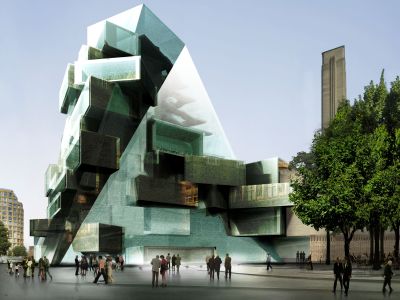Tate Modern extension gets green light
Tate Modern's £165 million extension this week received planning permission from Southwark Council. It could be ready in time for the 2012 London Olympics.

Southwark's planning committee approved the ambitious scheme on Tuesday night despite an eleventh-hour objection from IPC Media, the publishing firm moving into the Blue Fin Building on Southwark Street.
The 76-metre, 12-storey extension will be built at the south-west corner of the former Bankside Power Station. The extension has been designed by Herzog and de Meuron, the same architects responsible for the award-winning transformation of Giles Gilbert Scott's power station into Tate Modern.
As well as providing significant new gallery space for the display of works from Tate's collection, it will boast education facilities, two shops and six catering outlets.
Tate says that it needs the extension because of the huge success of the art gallery since it opened at Bankside in 2000. Tate Modern was designed to handle 1.8 million visitors a year but last year received 4.9 million visitors, causing overcrowding and putting a strain on visitor facilities.
Tate director Sir Nicholas Serota told the planning committee that the extension would "turn the building around" to look towards Southwark: "It will no longer be a building that relates only to the Thames".
The expanded Tate Modern is projected to draw another 1 million visitors to Bankside each year. It is expected to lead to the creation of more than 300 jobs in addition to the 565 currently employed at Tate Modern.
A key change for local residents and workers will be the creation of a new north-south pedestrian link across the Turbine Hall bridge, with public access for at least 12 hours a day. Sir Nicholas told councillors that this new link would serve to break "the huge block that Tate Modern currently represents".
The space to the south of Tate Modern will become Tate Square, a new forecourt and gathering space with terraced seats.
Objectors to the scheme included the Twentieth Century Society which criticised the "dominant and overpowering structure" and – in a personal capacity – the society's chairman, Professor Gavin Stamp, who lamented the demolition of the "particularly fine brickwork" on the south elevation and the loss of the current symmetry of the gallery.
In a strongly worded objection, Prof Stamp described the plans as "pretentious, excessively domineering and ill-thought-out".
IPC Media's objections
The planning committee heard a presentation from Geoff Bullock of RPS Planning representing IPC Media. The publishing firm is relocating this Easter from King's Reach Tower in Stamford Street to the Blue Fin Building (formerly known as Bankside 1) on the corner of Southwark Street and Sumner Street. IPC submitted a last-minute objection to the planning application on Tuesday afternoon, just hours before the planning committee met.Mr Bullock told councillors that his client had been in discussion with Tate for some time but felt that their concerns had not been taken on board. He listed IPC's objections which included overlooking and loss of privacy, the creation of an "enclosed and oppressive environment" at the corner of Sumner Street and Holland Street and traffic disruption from deliveries to the gallery.
Serota: "delighted"
Speaking outside Southwark Town Hall, Sir Nicholas Serota told the London SE1 website of his reaction to the planning committee's decision: "We're obviously delighted that the committee should have passed this unanimously, and that they have responded to the fact that local residents – who had some real concerns about this building which I understand – have gradually understood what the building is about [and] have recognised that the Tate is reflecting their concerns ... with vehicle movements and other such things.""Overall we will end up with a building which I think will be a real credit to Southwark and a landmark in London, and a very fine example of Herzog and de Meuron's work."
Work on the extension is expected to start in September 2008 to allow for the new building to be open by 2012.
It is expected that plans for 'Tate Modern 3', likely to be occupied by another cultural institution such as the Design Museum or BFI, will be brought forward for the land to the south-east of the former power station building.
• Proposed Section 106 planning obligations for the Tate extension include the setting up of a new Southwark Tourist Information Centre within or close to the Tate complex. Southwark's TIC left its home at Vinopolis last year and currently operates from a small counter at Tate Modern.
Comments
Share
The SE1 website is supported by people like you
More to read
- Sumner Street: council unveils car-free gateway to Tate Modern 18 May 2016
- Tate Modern extension will open on Friday 17 June 2016 25 Sep 2015
- Tate Modern extension: Southwark Council to give £1m 8 Sep 2015
- Tate Modern retains visitor record 15 Sep 2014
- Israeli shipping magnate gives £10 million to Tate Modern extension 2 Jul 2013
- Birthday honours for Tate's Nick Serota and NT's Nick Starr 15 Jun 2013
- £5 million funding boost for Tate Modern extension 12 Apr 2013
- Tate Modern extension 'on schedule' to welcome visitors in 2012 3 Mar 2011
- Fundraising for Tate Modern extension reaches half-way point 9 Sep 2010
- Boris Johnson starts enabling works for Tate Modern extension 6 Jan 2010
Follow us
Email newsletter
For the latest local news and events direct to your inbox every Monday, you need our weekly email newsletter SE1 Direct.

